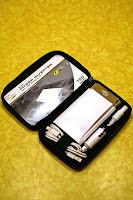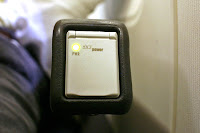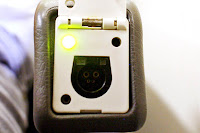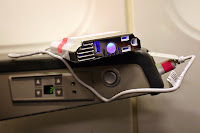In-seat Power & emPower Revisited : Working In Flight
Web: www.thetravelstrategist.com — E-Mail: fish@flyingwithfish.com
11/09/2008 – In-seat Power & emPower Revisited : Working In Flight
Many travelers want to stay productive while traveling. I often find I get more work done sitting in a cramped seat than sitting at my desk at home. When I am flying I am not distracted, no one is trying to have a conversation with me, my phone is not ringing, there is no email to check and I can’t flip on the TV. The key to staying productive is obviously keeping your laptop supplied with power.
While many airlines around the world are installing ‘standard’ 110v/220v electrical outlets in their newer aircraft, many airlines continue to use ‘emPower‘ outlets (American Airlines uses a standard automobile DC outlet) for in-seat power. emPower came into use in the 1990s as proprietary electrical power supply for commercial aircraft. This outlet is neither a standard auto-DC outlet or 110v/220v outlet, although many companies produce emPower inverters that are a combination of emPower & auto-DC outlet. An emPower tip is irregularly shaped with two larger ‘power pins’ and two smaller ‘grounding pins’ that slide into a specific emPower socket.
A common question I am asked by readers is where they can find emPower. The easiest place to find out what airlines have in-seat power, and on what aircraft and cabins is Seat Guru (www.seatguru.com). If you are flying on an aircraft equipped with emPower, the outlets are generally found in two places.
The first place to look for an emPower outlet, and the most common place, is in the armrest of your seat. It can be near the controls for the audio output or with some airlines in the front of the arm rest. The second most common place to find emPower is directly below the seat, between the two seat cushions.
If you are flying in business class, or first class, with an airline that offers emPower, the outlets can vary with the design of the seats as installed by the airline.
emPower outlets have a ready light with two colours. A red light means there is no power, while a green light means there is power.
It should be noted that some airlines that have emPower throughout an entire fleet may not have the outlets functioning. An example of this is US Airways. US Airways has emPower installed in all seats on-board the majority of their Airbus fleet. The problem with US Airways’ emPower system is that it is prone for failure. On my last 16 US Airways flights on Airbus aircraft have all been equipped with emPower, all showed a ‘green light,’ however I was only able to use the emPower on 4 of those flights. The others all had faulty emPower outlets, and in all cases I tested all three outlets in my row before determining they were truly faulty .
Most other airlines that offer emPower have it working in a consistent fashion. When I fly with Delta Airlines I routinely search for flights serviced by the Boeing 737-800 and 767-400 as they both offer in-seat power with emPower (some are being converted to standard 110v-Type B outlets, identical to ones found throughout the United States). In more than 250 segments on Delta 737-800 aircraft I have only found two non-fuctioning emPower outlets.
Aside from Delta Airlines, other airlines I have found to have very reliable emPower outlets include: Continental Airlines, Air Canada, Virgin Atlantic and United Airlines (who has 110v outlets on their 757-PS fleet and some new international premium cabin seats) .
While emPower inverters used to be fairly expensive when compared to a standard auto-inverter, many compact and reliable emPower inverters may not be found for around US$50-$75.
Below are photos of an actual functioning emPower outlet in the armrest of a US Airways Airbus A321 with my Vector 100w emPower inverter. The Vector iMobile Slim Power Inverter 100watt comes with both a standard Type-B 110v outlet and a USB outlet.
Happy Flying!






Interesting article. I always wondered what the connectors look like.
How about adding the pictures to the Wikipedia page you mentioned? Or even Wikitravel.org?
I could help adding them.
Hendrik,
I’m happy to hear you found this article informative.
You are welcome to use these images to update the Wiki page, or the WikiTravel sites.
The goal of Flying With Fish is to help people travel smarter and more effectively……and seems this post did just that for you :0)
Happy Flying!
-Fish
The best laptop adapter I’ve found is Kensington 120 adapter. It has ac/dc/empower and uses various tips for different laptops. Kensington has been just fantastic about sending me new tips (FREE!) when I get a new laptop. Can buy them on ebay for about $30. It’s also great at home, where I have one power cord at our desk, and me/hubbie use it by simply swapping out the tip.
ALAS, I just booked a flight from Chicago to Seattle only to learn (from seatguru and the airline) that United does not have ANY power for ANY coach seats on ANY planes. I will never fly United again. I’ve done a lot of American flights from west coast to Midwest and always had a functioning power outlet under my seat. It’s inconceivable to me that a major airline wouldn’t have any power to anyone in coach, which still has a large share of biz flyers with companies that won’t pay for biz or 1st class (I’m an attorney and even large corp clients won’t pay for biz class unless coach is completely sold out).
I just flew on Hawaiian Airlines and they no longer provide power to the EmPower recptacles on any of their airplanes. I had a similar problem recently in Europe (cannot recall the airline).
In both cases I got vague and non-responses from both cabin and cockpit crew members, leading me to think this is a security related issue and they will not talk about it?
Many airlines that had emPower outlets are moving to either removing in-seat power or to completely remove the in-seat power entirely.
In-seat power has no security or safety risks. The number of airlines adding in-seat power vs those removing it is significant. Airlines such as Delta are moving to roll in-seat power out through its fleet to bring in more business flyers, while US Airways is removing its in-seat power from its fleet in an effort to reduce the overall weight of the aircraft (and in turn they are losing a number of business flyers who flew them specifically for in-seat power).
The reason you’ll get vague answers from most airlines, is that most crews seem to little knowledge of the in-seat power or how it works.
Happy Flying!
-Fish